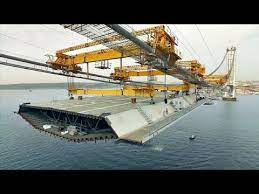Amazing Suspension Bridge construction Time Lapse How Suspension Bridges Are Built
Suspension bridges in their simplest form were originally made from rope and wood.
Modern suspension bridges use a box section roadway supported by high tensile strength cables.
In the early nineteenth century, suspension bridges used iron chains for cables. The high tensile cables used in most modern suspension bridges were introduced in the late nineteenth century.
Today, the cables are made of thousands of individual steel wires bound tightly together. Steel, which is very strong under tension, is an ideal material for cables; a single steel wire, only 0.1 inch thick, can support over half a ton without breaking.
Light, and strong, suspension bridges can span distances from 2,000 to 7,000 feet far longer than any other kind of bridge. They are ideal for covering busy waterways.
A suspension bridge suspends the roadway from huge main cables, which extends from one end of the bridge to the other. These cables rest on top of high towers and have to be securely anchored into the bank at either end of the bridge.
The towers enable the main cables to be draped over long distances. Most of the weight or load of the bridge is transferred by the cables to the anchorage systems. These are imbedded in either solid rock or huge concrete blocks. Inside the anchorages, the cables are spread over a large area to evenly distribute the load and to prevent the cables from breaking free.
ENJOY! This Amazing Suspension bridge was constructed with incredible machine equipment and most advanced technology at it's time.
Suspension bridges in their simplest form were originally made from rope and wood.
Modern suspension bridges use a box section roadway supported by high tensile strength cables.
In the early nineteenth century, suspension bridges used iron chains for cables. The high tensile cables used in most modern suspension bridges were introduced in the late nineteenth century.
Today, the cables are made of thousands of individual steel wires bound tightly together. Steel, which is very strong under tension, is an ideal material for cables; a single steel wire, only 0.1 inch thick, can support over half a ton without breaking.
Light, and strong, suspension bridges can span distances from 2,000 to 7,000 feet far longer than any other kind of bridge. They are ideal for covering busy waterways.
A suspension bridge suspends the roadway from huge main cables, which extends from one end of the bridge to the other. These cables rest on top of high towers and have to be securely anchored into the bank at either end of the bridge.
The towers enable the main cables to be draped over long distances. Most of the weight or load of the bridge is transferred by the cables to the anchorage systems. These are imbedded in either solid rock or huge concrete blocks. Inside the anchorages, the cables are spread over a large area to evenly distribute the load and to prevent the cables from breaking free.
ENJOY! This Amazing Suspension bridge was constructed with incredible machine equipment and most advanced technology at it's time.







![Transformateurs triphasés [ l'étoile - triangle]](https://blogger.googleusercontent.com/img/b/R29vZ2xl/AVvXsEgfrGJWOWiKdh5DvfZk3WZSqBi10gXs2khB0NJtJhI44hX7zjU1gkqKTpeTDbpmMEzgZXpfdzdyIDt6xOo7P1bZbYfm5_Jb4LQ8TZFzybV_heL92b5TI7yk1noqyINhckwGqU4dR70A8sDd/s72-c/triangle-etoile.png)
No comments